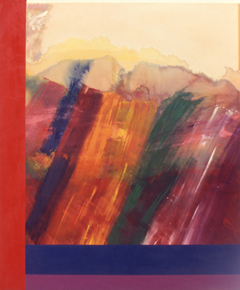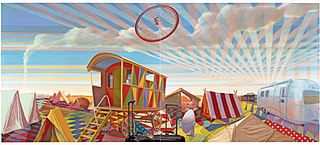Related Research Articles
John Walker is an English painter and printmaker. He has been called "one of the standout abstract painters of the last 50 years."
Morris Louis Bernstein, known professionally as Morris Louis, was an American painter. During the 1950s he became one of the earliest exponents of Color Field painting. While living in Washington, D.C., Louis, along with Kenneth Noland and other Washington painters, formed an art movement that is known today as the Washington Color School.
Zahoor ul Akhlaq was a pioneering artist from Pakistan. He is known for his approach to painting, sculpture, design and architecture, as well as his teaching at the NCA in Lahore.

Ronnie Landfield is an American abstract painter. During his early career from the mid-1960s through the 1970s his paintings were associated with Lyrical Abstraction, and he was represented by the David Whitney Gallery and the André Emmerich Gallery.
Friedel Dzubas was a German-born American abstract painter.
Il Lee is a Korean-born American contemporary artist. He was born in South Korea and has been living in America since the mid-1970s. Il Lee is best known for his ballpoint pen artwork; large-scale abstract imagery on paper and canvas. He also creates artwork in a similar vein utilizing acrylic and oil paint on canvas. Exhibitions of Il Lee's artwork have been held in Seoul, Tokyo, Hong Kong, Paris, New Delhi, Mexico City, and numerous cities across the United States. The New York Times has described Lee's ballpoint artwork as "deceptively casual; sweeping, rhythmical abstractions in blue."

Augustus Vincent Tack (1870–1949) was an American painter of portraits, landscapes and abstractions.

Kim Whanki was a painter and pioneering abstract artist of Korea, born in the village of Eupdong-ri on the island of Kijwa, of Anjwa-myeon, Sinan County, South Jeolla Province in Korea under Japanese rule. Kim lived and worked in a number of cities and countries during his lifetime, including Tokyo, Japan; Seoul and Busan, Korea; Paris, France; and New York City, USA, where he passed away.

Lee Ufan is a Korean minimalist painter and sculptor artist and academic, honored by the government of Japan for having "contributed to the development of contemporary art in Japan." The art of this artist, who has long been based in Japan, is rooted in an Eastern appreciation of the nature of materials and also in modern European phenomenology. The origin of Mono-ha may be found in Lee's article "Sonzai to mu wo koete Sekine Nobuo ron (Beyond Being and Nothingness – A Thesis on Sekine Nobuo." Once this initial impetus given, Mono-ha congealed with the participation of the students of the sculptor Yoshishige Saitō, who was teaching at Tama University of Art at the time. One evidence may be found in the book [ba, so, toki]. Lee, the main theorist of the Mono-ha tendency in Japan in the late 1960s and early 1970s, was trained as a philosopher. As a painter, Lee contributed to 'Korean Monotone Art', the first artistic movement in 20th century Korea to be promoted in Japan. He advocates a methodology of de-westernization and demodernization in both theory and practice as an antidote to the Eurocentric thought of 1960s postwar Japanese society. Lee divides his time between Kamakura, Japan and Paris, France.
Angel Otero was born 1981. He is a contemporary visual artist specializing in painting.
Alvin D. Loving Jr., better known as Al Loving, was an African-American abstract expressionist painter. His work is known for hard-edge abstraction, fabric constructions, and large paper collages, all exploring complicated color relationships.
Jacob Kassay is a post-conceptual artist best known for his work in painting, filmmaking, and sculpture. Critics have noted the influence of minimalist music and composition on his work, which applies a structural approach to the biological mechanisms of sight and spatial recognition. Kassay currently lives in New York City and is represented by 303 Gallery.
Edgar Hubert (1906-1985) was a British abstract painter.

Ulrike Müller is a contemporary visual artist. Müller is a member of the New York-based feminist genderqueer group LTTR as well as an editor of its eponymous journal. She also represented Austria at the Cairo Biennale in 2011. She is currently a professor and Co-Chair of Painting at the Milton Avery Graduate School of the Arts at Bard College in Annandale-on-Hudson, New York.

Titus Kaphar is an American contemporary painter whose work reconfigures and regenerates art history to include the African-American subject. His paintings are held in the collections of Museum of Modern Art, Brooklyn Museum, Yale University Art Gallery, New Britain Museum of American Art, Seattle Art Museum, Virginia Museum of Fine Arts, and University of Michigan Museum of Art.

Victor George Kord is an American painter and educator. He currently maintains a studio and exhibits in New York City. He previously served as art department chair for several major universities, and remains professor emeritus of painting at Cornell University Department of Art.

John Opper (1908–1994) was an American painter who transitioned from semi-abstract paintings in the late 1930s to fully abstract ones in the 1950s. He became known for his handling of color and in particular his ability to create dramatic intensity on the picture plane by means of juxtaposed, more-or-less rectangular areas of color. He was associated with the abstract expressionist movement and frequently showed in galleries that specialized in abstract expressionist art. Late in life, he described his style by what it was not. He said, "The whole is the sum of its parts. That's what my school of abstract art is about, a school that evolved from nature, not conceptual, not geometric, not hard-edged. It's only art."

Ralph Rosenborg (1913–1992) was an American artist whose paintings were described as both expressionist and abstract and who was a colleague of the New York Abstract Expressionists in the 1940s and 1950s. Unlike them, however, he preferred to make small works and tended to explicitly draw upon natural forms and figures for his abstract subjects. Called a "highly personal artist," he developed a unique style that was considered to be both mystical and magic. His career was exceptionally long, covering more than 50 years and his output was correspondingly large.

Greg Drasler is an American artist known for metaphorical paintings that mix vernacular imagery and decoration and visual and interpretive conundrums. His work explores the construction of identity and memory through painted subjects that range from elaborately constructed interiors to symbolic common objects to patterned panoramas of the American highway. Although representational, Drasler's work eludes defined aesthetic categories such as realism, incorporating elements of surrealism, abstraction, and postmodern bricolage and recontextualization. In an early Art in America review, Robert G. Edelman wrote that Drasler "shares with Magritte the ability to create images that are both convincing and profoundly disorienting"; Jonathan Goodman described his later paintings as enigmatic puzzles meant to be meditated on, as both "visual metaphors for self" and formal statements existing for the sake of psychological mystery. Drasler has been awarded a Guggenheim Fellowship and grants from the Pollock-Krasner Foundation, National Endowment for the Arts and New York Foundation for the Arts. His work has been shown at the New Museum, PS1, Whitney Museum Stamford, Artists Space and Carnegie Museum of Art, and reviewed or featured in Art in America, Flash Art, New Art Examiner, The Paris Review, and The New York Times. Drasler lives in Tribeca, New York City with his wife, artist Nancy Davidson, and teaches at Pratt Institute.
Caitlin Cherry is an African-American painter, sculptor, and educator.
References
- 1 2 3 4 5 6 7 8 9 10 11 12 13 "Kanishka Raja's Life Between Two Worlds". Hyperallergic. 2018-09-01. Retrieved 2019-03-17.
- 1 2 3 4 "A Tribute to Kanishka Raja". Asia Society. Retrieved 2019-03-17.
- 1 2 3 4 5 6 "ArtAsiaPacific: Obituary Kanishka Raja19702018". artasiapacific.com. Retrieved 2019-03-17.
- 1 2 3 4 "Always Wanting to Break with Geography: Remembering Kanishka Raja (1969–2018)". frieze.com. Retrieved 2019-03-24.
- 1 2 3 4 5 6 7 "Yale University School of Art: Kanishka Raja". art.yale.edu. Retrieved 2019-03-17.
- 1 2 Artbite (2012-03-29). "ArtBite: Artist Interview Series! Kanishka Raja". ArtBite. Retrieved 2019-03-17.
- ↑ Raja, Kanishka. "Kanishka Raja – HILOBROW" . Retrieved 2019-03-17.
- 1 2 ""Dissolution of the Prepublic" by Kanishka Raja on display at the Annenberg School | Annenberg School for Communication". www.asc.upenn.edu. Retrieved 2019-03-17.
- ↑ Foundation, Joan Mitchell. "Artist Programs » Artist Grants". joanmitchellfoundation.org. Retrieved 2019-03-17.